The Apple iPad Air 2 Review
by Joshua Ho on November 7, 2014 9:30 AM EST- Posted in
- Tablets
- Apple
- Mobile
- iOS
- ipad Air 2
CPU Performance
Now that we’ve managed to take a good look at the changes between the A8 and A8X, we can get a good idea of what those differences translate to in some real world performance. While we’ve already seen pure CPU performance, such differences can be small when viewed from real applications. To this end, we use a few browser benchmarks and similar benchmarks. I definitely want to caution against comparing SoCs across platforms though, as rendering engines have a significant effect upon the performance of the device.


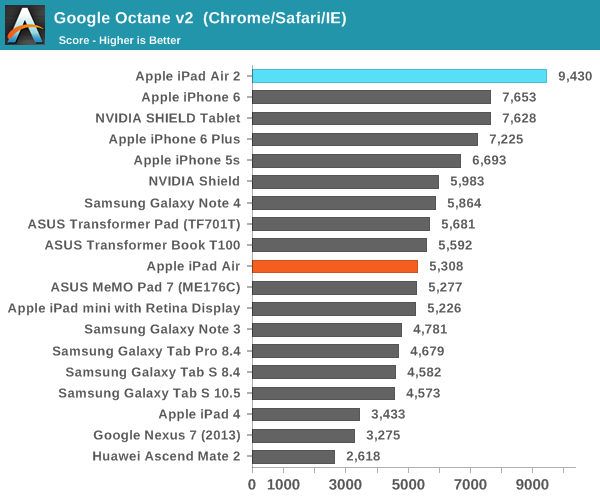
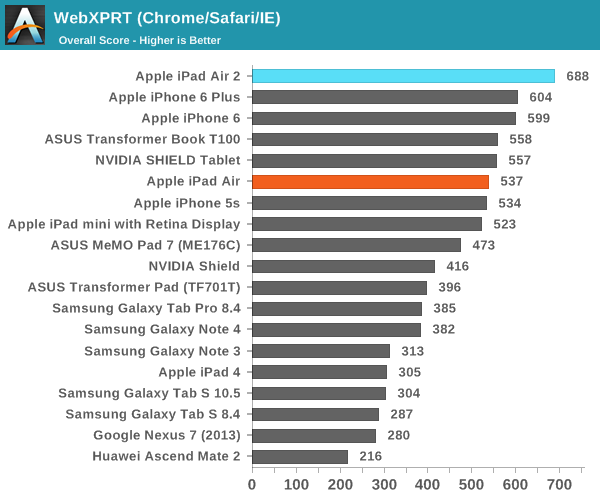

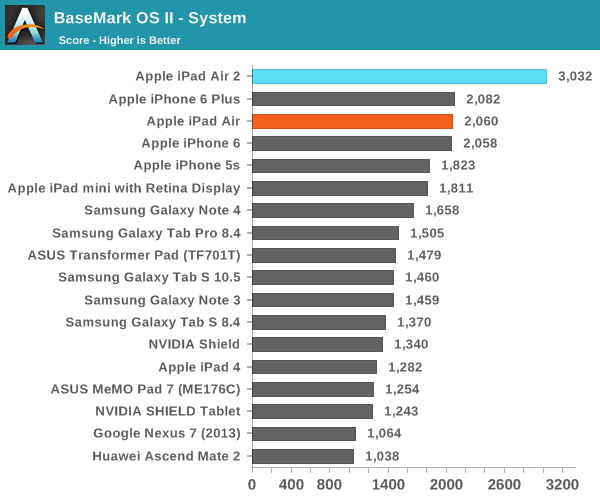
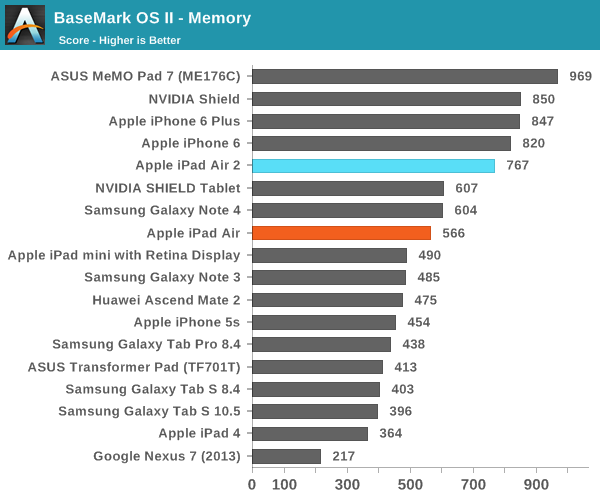
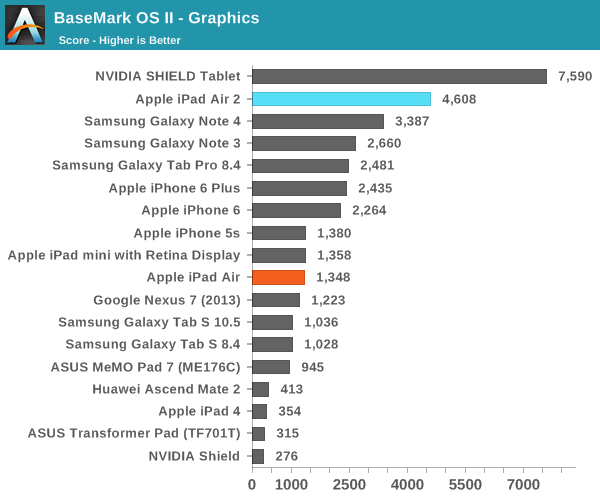
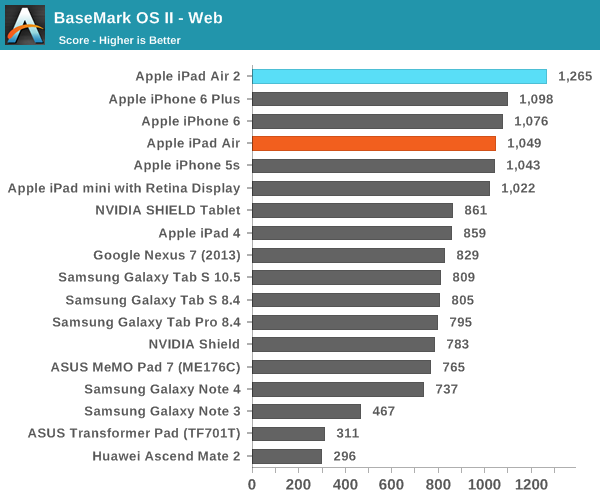
There's really not too much that needs to be said here, as the extra core and minor clock speed bump make for ridiculous amounts of performance. The A8X is class-leading here despite generally having fewer cores and lower clocks than the rest of the competition. However, in comparison to A8 we don't see a massive jump in performance. This seems to suggest that even a third core will invoke diminishing returns in general, although these changes mean that it's enough for the iPad Air 2 to be one of the fastest ARM-based devices on the market. One can see an odd regression in the Basemark OS II storage test, but this is likely to be production variances in NAND quality rather than anything notable.










226 Comments
View All Comments
Speedfriend - Friday, November 7, 2014 - link
When I read about the A8, it make me wonder about the A7. With the A8 Apple claims to have improved energy efficiency over the A7 by 50%. Now a iPhone 6 Plus driving a 1920x1020 screen has the same 10 hour battery life as a Galaxy Note 3 which also has a 1920 x 1080 screen. But that means that if Apple had tried to build a phablet with the A7, they would have ended up with a battery life of around 6.5 hours, clearly not competitive with Samsung’s offerings.So to me it looks like Apple didn’t build a bigger screen phone before not because they didn’t feel there was demand but because they simply wouldn’t have been able to compete on battery life and that is why the whole focus with the A8 was improving efficiency rather than simply performance.
So was the A7 just very uncompetitive to other ARM designs or is iOS inefficient compared to Android.
I would love to see someone do some digging on this – Anandtech?
dmunsie - Friday, November 7, 2014 - link
I don't think this has anything to do with either the A7 design or iOS -- there are too many variables in the equation to definitively say. Plus unlike other ARM designs and Android, there is only one source for the A7 and iOS -- Apple. So you can't just take iOS and install it on the same hardware as another Android device and compare.The A7 was also used in the iPad and iPad mini last year where it got an advertised 10 hour battery life. If Apple had made a Plus sized iPhone last year, they probably would've had to make it thicker to get to their target battery life, which is probably similar to what Samsung has done with their designs. Apple never likes to go thicker if they can avoid it.
You can see how Apple values size over battery life because with the move to the A8X, the Air 2 got thinner with the same battery life vs staying the same size but with more battery life. Not saying that valuing battery live over size is better than what Apple chose, but they are clearly making it known what they are optimizing for here.
Impulses - Friday, November 7, 2014 - link
As an Android fan, I'd love to see Apple stop chasing thinness and actually improve battery life by a large degree... They could've done so with the iPhone 6 and chased the claim of "2 day battery life", but they chose thinness instead.Having Apple claiming two day battery life on a phone and destroying everything else by a large margin would definitely light a fire under everyone... Over engineering for 7mm thickness vs 8.5 mm seems quite pointless to me, anything under 9 is quite enough on a phone.
It seems structurally speaking they're better off to, e.g. bendgate...
sonicmerlin - Friday, November 7, 2014 - link
Personally I'd like my phone to be as thin as a credit card.akdj - Thursday, November 27, 2014 - link
Be state came and went in ten minutes. It's a non issueMight check those up times on the 6+ again. They reflect almost identical performance as mine. I could go two days, easily.
Speedfriend - Monday, November 10, 2014 - link
Except the note and the iPhone 6+ have the same size battery, so samsung hasn't had to use a bigger battery to get the same battery life.techconc - Friday, November 7, 2014 - link
You "analysis" fails to consider the size of the battery in existing devices as part of the equation. Likewise, your conclusion regarding the A7 design not being competitive is completely baseless. What's more, you also fail to consider the manufacturing process as a variable as well. The primary efficiency difference between the A8 and A7 has much more to do with the manufacturing process moving from 28nm to 20nm.Finally, if you wish to compare Apple's chips with the competition or iOS vs. Android in terms of efficiency, you should ask yourself why Android phones require more memory to perform the same tasks and why Android devices need such a bigger battery in order to get the same level of usage and/or performance.
Speedfriend - Monday, November 10, 2014 - link
At techconcBattery size is almost identical. Manufacturing process has absolutey nothing to do with it. Or the efficiency difference between A8 and A7. It is a fairly simply equation - at same battery size, A8 equipe diPhone 6+ gives smae battery life as Note 3/4. Swap out A8 for A7 and you would get 1/3 less battery life based on Apple's 50% A8 over A7 efficiency claim. Hence why no big iPhone before.
tipoo - Friday, November 7, 2014 - link
Yup, when I saw the teardown with two RAM banks rather than the usual one, I was expecting 25.6GB/sec, with double the pins/bits going into the SoC. And it also makes sense with the huge GPU gains, something has to feed that beast. Crazy, that's now in laptop bandwidth range.cynic783 - Friday, November 7, 2014 - link
and we made it about 10 comments before the "Anand is an Apple shill" accusation lol. so much Android butt hurt.